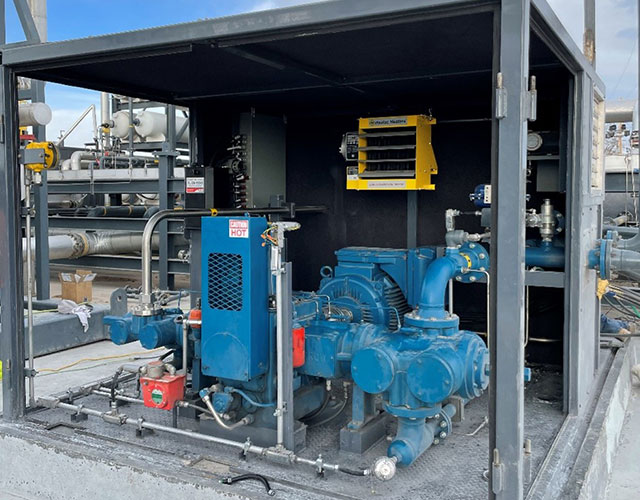In the renewable energy sector, ensuring the smooth operation of machinery is paramount. At Flexaseal, we specialize in identifying and rectifying issues that can lead to significant downtime. Our recent project at a dairy farm in Idaho is a testament to our expertise in providing Seals. Systems. Solutions. At Your Speed. Let’s delve into the intricate process of reworking a renewable natural gas compressor, enhancing its efficiency and reliability.
The Initial Challenge: High Vibration Issues
In early December 2022, we were summoned to a dairy farm in Idaho to address a critical issue: the farm’s renewable natural gas compressor was experiencing very high vibrations during production. The concern was that this could lead to a catastrophic failure if not addressed promptly.
Technical Overview
The machine in question was a two-throw separable reciprocating compressor, equipped with a 7” low pressure head and a 4” high pressure head, and powered by a 250HP motor capable of reaching up to 1800RPM. This entire setup was housed on a fabricated machine skid, complemented by a large heat exchanger at the back.
Initial Findings
Upon our initial assessment, we found that the alignment was not significantly out of spec, but it certainly required corrective action to achieve optimal alignment. Our vibration testing revealed a dominant 2x peak, representing the piston frequency, which reached up to 0.529 inch/sec. Through a comprehensive run-up/coast-down test, we identified the natural frequencies being excited and visualized the ideal run speed to avoid resonance.
Our motion amplification study, which will be vividly illustrated in the accompanying videos, highlighted several weaknesses in the base that were contributing to the issues. Notably, the initial grouting of the skid was insufficient, leaving numerous gaps in the cavities and rendering the grout ineffective.
The Solution: A Comprehensive Rework
Armed with this data, we proposed a comprehensive solution to the farm: the design and manufacture of a reinforced base to address the identified weaknesses.
The Rework Process
The compressor was transported to our Houston, TX shop for a complete overhaul. This involved transplanting it onto the newly designed skid and replacing the old concrete base. During this phase, we conducted acceptance testing, which showed that the compressor was running much smoother than before.
Final Installation and Results

In late April, the rejuvenated compressor made its way back to Idaho. The installation process was meticulous:
- The skid was anchored down and properly grouted.
- Laser alignment ensured optimal operation.
- The compressor was seamlessly integrated back into the pipeline, ready to run.
Exceeding Expectations
The final acceptance testing revealed impressive results. The overall vibration had decreased tenfold at its most extreme points, with most other points showing a 2-3 times reduction. The vibration analysis now indicates that the compressor is in good condition and clear of resonance.
Conclusion: A Successful Transformation
This project not only averted a potential catastrophic failure but also significantly enhanced the efficiency and reliability of the compressor. The customer was extremely satisfied with the outcome, now possessing a compressor that promises reliability through production.
We invite you to view the short video of our motion amplification study and the before-and-after graphs that vividly illustrate the remarkable transformation achieved through this project.
Feel free to contact us for more insights into our innovative solutions. At Flexaseal, we are committed to delivering Seals. Systems. Solutions. At Your Speed, ensuring your production runs smoothly and efficiently.
